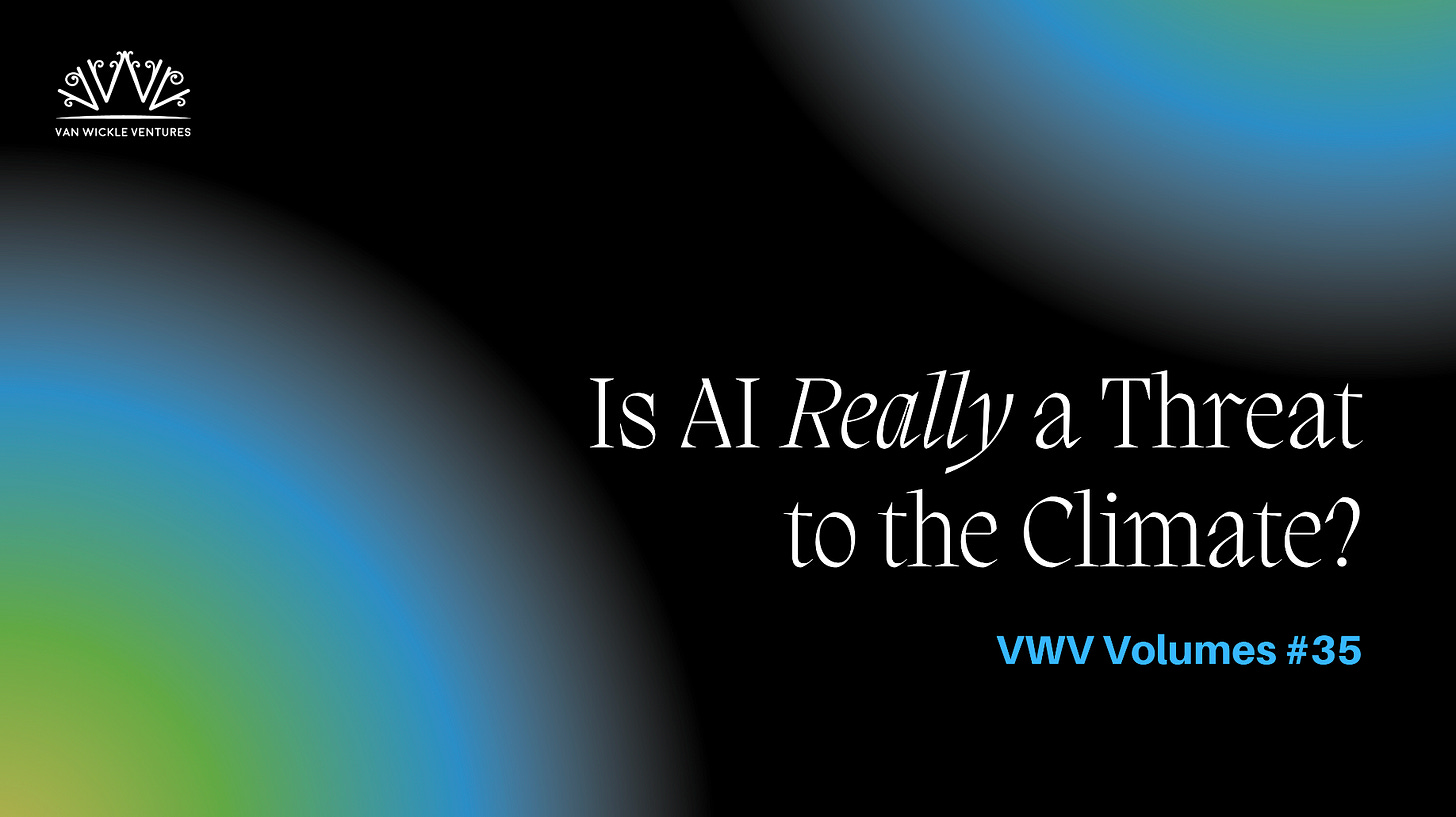☀️VWV Volumes #35: Analyst-in-Training Roman Novy-Marx on AI and Sustainability
In this week's volume, Roman discusses the hidden costs of technological progress and how AI is reshaping our understanding of sustainability.
Is AI Really a Threat to the Climate? 🌎
As artificial intelligence gobbles up more and more electricity, it will significantly worsen our climate crisis, right? Not so fast. While wildfires rage and rising seas batter coastlines, the immense power of AI may lie untapped, overshadowed by fears of its energy use.
What if AI is not the enemy, but an emerging ally in the transition toward a sustainable world?
Let’s get some facts straight. Global AI servers do consume massive amounts of electricity, an estimated 85 to 134 terawatt hours annually per VU Amsterdam, about the same demand as the entire Netherlands. Further, Statista projects a year-over-year compounding growth of 28.46% through 2030. While there’s no doubt that’s a lot of energy, it’s less than half a percent of global consumption for perspective, according to VU Amsterdam’s calculations. What if the solutions and efficiencies AI can bring far outweighs these numbers?
Accelerating Climate Solutions ♻️
The majority of AI applications don’t actually require lots of energy, says Priya Donti, an MIT professor and co-founder of Climate Change AI. While initially training models can be intensive, it’s a one time cost, with most models then able to run smoothly on a laptop. More importantly, AI brings us the tools to accelerate our search for and implementation of climate solutions. In “Tackling Climate Change With Machine Learning,” a paper Donti co-authored with 21 fellow experts in 2022 to advocate the climate applications of machine learning, she stresses that the quantity of climate-related data we now have far exceeds our human capacity to analyze it. However, AI can help.
One straightforward example involves training AI models to increase the electrical efficiency of buildings. As European energy company Vattenfall describes, "By considering various factors such as solar radiation and weather forecasts, the system can stay one step ahead and predict the amount of heat the different parts of the building need to maintain the right temperature with the least possible supply of heat.”
Extensive testing of this technology in two Swedish apartment buildings with 119 units has reduced energy consumption by about 20 percent. Experts are optimistic that essentially all buildings can improve their efficiency with such technology. Given that the global operation of buildings constitutes 28% of the world’s final electricity consumption, according to the UN’s 2020 Global Status Report for Buildings and Construction, the potential impacts of such a reduction would be a significant step towards decarbonization.
More specifically, space heating contributes about ⅓ of the energy used for American building operations, as calculated by the U.S. Energy Information Administration. Assuming a similar figure globally, space heating is accountable for about 9.3% (ie. 28% * ⅓) of the world’s final electricity use. Now, assuming a 20 percent reduction in line with Swedish results, the implementation of AI to optimize building heat alone has the ability to save 1.86% of the world’s annual electricity. That’s equivalent to reducing about 425 terawatt hours of electricity according to the International Energy Agency (IEA)—over 3x the annual consumption of the entire global AI sector on the conservative end as estimated by the NY Times, and that’s only one of the many climate-related AI applications.
Better Data 🤖
Another example of the power AI offers in supporting efforts against climate change is its ability to accurately analyze complex imagery. Open Climate Fix, a non-profit using computing to reduce carbon emissions, is training AI models to read cloud cover from satellite data in order to form estimates that better match electricity demand with short-term solar energy production. With improved supply-demand estimates, fewer natural gas generators must be kept on spinning reserve, a concept highlighted by the Electricity Advisory Committee. Open Climate Fix believes that their AI forecasts could save £1-10 million and about 100,000 tonnes of CO2 per year in the UK alone.
Researchers from the University of Leeds in the UK have also trained AI models to measure changes in icebergs 10,000 times faster than a human could. Their groundbreaking development uses a neural network that accurately charts Antarctic icebergs in satellite images in just 0.01 seconds. The neural network has proven over 99% accurate with radar images from Sentinel-1, regardless of cloud cover. Previously, such data collection required time-consuming manual efforts.
Perfection Is the Enemy of the Good 😈
This AI-collected data helps scientists understand and quantify how much meltwater and nutrients these icebergs release into the ocean, which is important for ocean physics, biology, and maritime operations. These vastly improved methods of data collection may also help give climate change skeptics a new perspective or better communicate the urgency of our climate crisis to those living near coastlines.
Still, such examples barely scratch the surface. Artificial intelligence provides the tools for precise climate modeling and improved resource efficiencies across nearly all sectors of the economy. While AI demand does challenge our aged and vulnerable grid, it has begun to show its potential for optimizing energy use and understanding our critical situation.
As we stand at a pivotal moment in our environmental crisis, it is essential that we leverage every tool available. That means including artificial intelligence, not just railing at it.
About the Author
Roman is a sophomore at Brown University, studying Environmental Science and Business Economics. He works with Van Wickle Ventures, Brown Investment Group, and Brown Students in Real Estate. Roman also founded Pure Puka in 2022, an eco-friendly jewelry brand crafting pieces from shells and other natural materials. Roman has worked with Impellent Ventures and, on Tradewater’s Marketing and Communications team, he currently helps build the carbon credit market for destroyed refrigerants and plugged methane wells.



